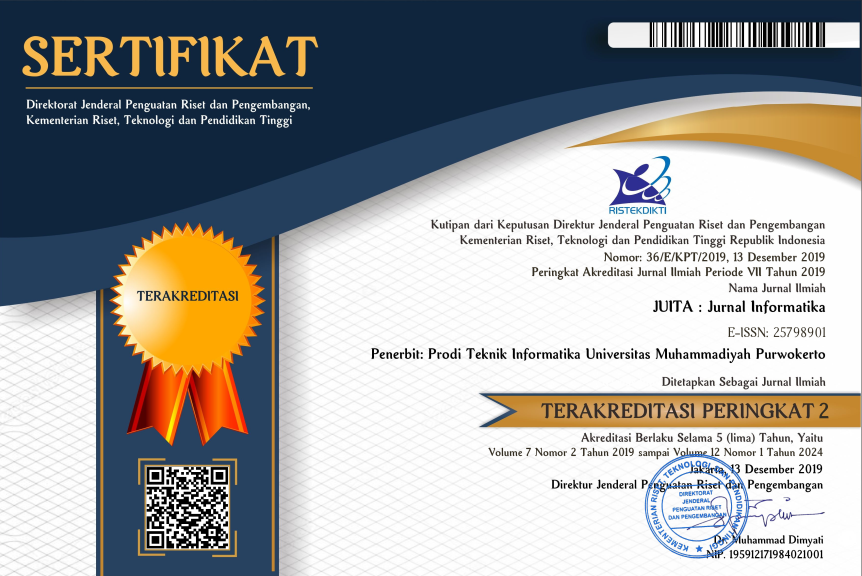Modified of Single Deepest Vertical Detection (SDVD) Algorithm for Amniotic Fluid Volume Classification
Abstract
Amniotic fluid a crucial role in ensuring the well-being of the fetus during pregnancy and is contained within the amnion cavity, which is surrounded by a membrane. Several studies have shown that volume of amniotic fluid can vary throughout pregnancy and is closely linked to the health and safety of the fetus. This indicates that it is essential to perform accurate measurement and identification of its volume. Obstetric specialist often use a manual method to identify amniotic fluid by visually determining the longest straight vertical line between the upper and lower boundaries. Therefore, this study aims to develop detection model, known as modified Single Deepest Vertical Detection (SDVD) algorithm to automatically measure the longest vertical line by following medical rules and regulations. SDVD algorithm was designed to measure the depth of amniotic fluid vertically by searching the column of pixels that comprised the image sample, excluding any intersection with the fetal body. Performance testing was carried out using 130 images by comparing the manual measurement results obtained by obstetric specialists and the proposed model. Based on the experimental results using modified SDVD, the average accuracy, precision, and recall achieved for amniotic fluid classification were 92.63%, 85.23%, and 95.6%, respectively.
Keywords
References
[1] S. Posh, S. Rafiq, M. Dar, R. Aslam, and S. Bhat, “Role of amniotic fluid echogenicities in the prediction of fetal outcome,” J. Sci. Soc., vol. 47, no. 1, p. 33, 2020, doi: https://doi.org/10.4103/jss.jss_9_20.
[2] W. Dc and L. Rock, “Dubil2013,” vol. 16, no. May, 2013.
[3] X. L. Tong, L. Wang, T. B. Gao, Y. G. Qin, Y. Q. Qi, and Y. P. Xu, “Potential function of amniotic fluid in fetal development-novel insights by comparing the composition of human amniotic fluid with umbilical cord and maternal serum at mid and late gestation,” J. Chinese Med. Assoc., vol. 72, no. 7, pp. 368–373, 2009, doi:https://doi.org/10.1016/S1726-4901(09)70389-2.
[4] G. Tam and T. Al-Dughaishi, “Case report and literature review of very echogenic amniotic fluid at term and its clinical significance,” Oman Med. J., vol. 28, no. 6, pp. 28–30, 2013, doi: https://doi.org/10.5001/omj.2013.129.
[5] L. Dallaire and M. Potier, “Amniotic fluid,” Encyclopedia of Reproduction, vol. 3. Elsevier, pp. 53–97, 2012.
[6] A. F. Nabhan and Y. A. Abdelmoula, “Amniotic fluid index versus single deepest vertical pocket: a meta-analysis of randomized controlled trials,” J. Gynecol. Obstet., vol. 104, no. 3, pp. 184–188, 2009, doi: https://doi.org/10.1016/j.ijgo.2008.10.018.
[7] M. H. Beall, J. P. H. M. van den Wijngaard, M. J. C. van Gemert, and M. G. Ross, “Amniotic Fluid Water Dynamics,” Placenta, vol. 28, no. 8–9, pp. 816–823, 2007, doi: https://doi.org/10.1016/j.placenta.2006.11.009.
[8] M. I. Martínez-León, “Fetal imaging,” J. Ultrasound Med., vol. 33, no. 5, pp. 745–757, 2014.
[9] S. Kehl, A. Schelkle, A. Thomas, A. Puhl, K. Meqdad, B. Tuschy, S. Berlit, C. Weiss, C. Bayer, J. Heimrich, U., “Single deepest vertical pocket or amniotic fluid index as evaluation test for predicting adverse pregnancy outcome (SAFE trial): A multicenter, open-label, randomized controlled trial,” Ultrasound Obstet. Gynecol., vol. 47, no. 6, pp. 674–679, 2016, doi: https://doi.org/10.1002/uog.14924.
[10] S. Q. Rashid, “Amniotic fluid volume assessment using the single deepest pocket technique in bangladesh,” J. Med. Ultrasound, vol. 21, no. 4, pp. 202–206, 2013, doi: https://doi.org/10.1016/j.jmu.2013.10.011.
[11] P. D. W. Ayu, S. Hartati, A. Musdholifah, and D. S. Nurdiati, “Amniotic fluid segmentation based on pixel classification using local window information and distance angle pixel,” Appl. Soft Comput., vol. 107, 2021, doi: https://doi.org/10.1016/j.asoc.2021.107196.
[12] H.C. Cho, S. Sun, C. Min Hyun, J.Y. Kwon, B. Kim, Y. Park, J.K. Seo, “Automated ultrasound assessment of amniotic fluid index using deep learning,” Med. Image Anal., vol. 69, p. 101951, 2021, doi: doi.org/10.1016/j.media.2020.101951, doi: https://doi.org/10.1016/j.media.2020.101951.
[13] P. D. W. Ayu, S. Hartati, A. Musdholifah, and D. S. Nurdiati, “Amniotic fluid classification based on volume and echogenicity using single deep pocket and texture feature,” ICIC Express Lett., vol. 15, no. 7, pp. 681–691, 2021, doi: https://doi.org/10.24507/icicel.15.07.681.
[14] D. S. N. Ayu, P D W, Sri hartati, Aina Musdholifah, “Amniotic Fluids Classification Using Combination of Rules-Based and Random Forest Algorithm,” in Soft Computing in Data Science, 2022, p. 15, doi: https://doi.org/https://doi.org/10.1007/978-981-16-7334-4_20.
[15] P. D. W. Ayu, S. Hartati, A. Musdholifah, and D. S. Nurdiati, “Amniotic fluid segmentation based on pixel classification using local window information and distance angle pixel,” Appl. Soft Comput., vol. 107, p. 107196, 2021, doi: https://doi.org/10.1016/j.asoc.2021.107196.
[16] P. D. Wulaning Ayu and G. A. Pradipta, “U-Net Tuning Hyperparameter for Segmentation in Amniotic Fluid Ultrasonography Image,” 2022 4th Int. Conf. Cybern. Intell. Syst. ICORIS 2022, 2022, doi: https://doi.org/10.1109/ICORIS56080.2022.10031294.
[17] O. Ronneberger, P. Fischer, and T. Brox, “U-net: convolutional networks for biomedical image segmentation,” Lect. Notes Comput. Sci., vol. 9351, pp. 234–241, 2015, doi: https://doi.org/10.1007/978-3-319-24574-4_28.
[18] M. Han, Y. Bao, Z. Sun, S. Wen, L. Xia, J. Zhao, J. Du, Z. Yan, “Automatic segmentation of human placenta images with u-net,” J. IEEE Access, vol. 7, pp. 180083–180092, 2019, doi: https://doi.org/10.1109/ACCESS.2019.2958133.
[19] K. bing Chen, Y. Xuan, A. jun Lin, and S. hua Guo, “Lung computed tomography image segmentation based on U-Net network fused with dilated convolution,” Comput. Methods Programs Biomed., vol. 207, p. 106170, Aug. 2021, doi: https://doi.org/10.1016/J.CMPB.2021.106170.
[20] P. D. W. Ayu and S. Hartati, “Pixel Classification Based on Local Gray Level Rectangle Window Sampling for Amniotic Fluid Segmentation,” Int. J. Intell. Eng. Syst., vol. 14, no. 1, pp. 420–432, 2021, doi: https://doi.org/10.22266/IJIES2021.0228.39.
DOI: 10.30595/juita.v11i2.18435
Refbacks
- There are currently no refbacks.

This work is licensed under a Creative Commons Attribution 4.0 International License.
ISSN: 2579-8901
- Visitor Stats
View JUITA Stats










